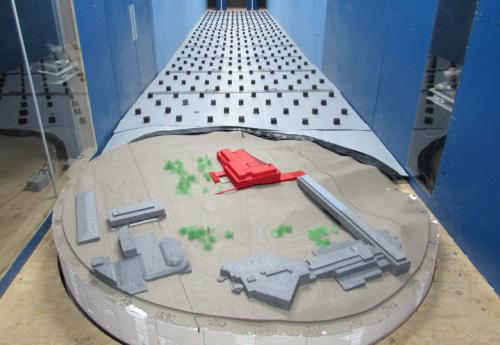Planning work on the University of Lethbridge’s new Science and Academic Building (SAB) has taken into account an enormous amount of variables, including one of the most prevalent factors in southern Alberta – the wind.
The shovel-ready Destination Project is scheduled to break ground this spring, pending available government funding, and when it does, the building’s design will reflect comprehensive study of how southern Alberta’s winds will interact with KPMB|Stantec Architects’ proposed SAB design.

“This is the most significant project the University has undertaken since the construction of the original University Hall, and it will radically alter the landscape of our campus,” says Brian Sullivan, program director for the Destination Project office. “It is a simple, flexible and adaptable layout but because of its sheer size and capacity, adding 36,000 sq. metres to the campus footprint, it is imperative we complete our due diligence on every aspect of its design, including how wind will affect its performance.”
In October 2015, Guelph, Ontario-based RWDI Consulting Engineers & Scientists was enlisted to perform a series of tests from exhaust dispersion to clean air intake to pedestrian wind patterns, snow drifting and everything in between. The tests helped shape design alterations for KPMB|Stantec, as well as wind mitigation techniques for areas around the new building.
The testing involved the creation of a 1/300 scale model of the U of L campus, including the new SAB. The model was then placed on an eight-foot diameter disc in RWDI’s wind tunnel and subjected to a multitude of wind speeds and directions.
“We got involved early on in the project, when things weren’t solidified from a mechanical design perspective, so we were able to work with the mechanical engineer and provide input as the building developed,” says Sonia Beaulieu, senior project manager with RWDI.
The testing then included measuring emissions from exhaust stacks by pumping carbon monoxide through small copper pipes that replicate the stacks in the building.
“We then measured the carbon monoxide concentrations at each of the fresh air intakes or sensitive pedestrian locations. We do that for a full array of approaching wind directions and varying wind speeds,” says Beaulieu. “Once we got our results, we then combined it with meteorological data and figured out how often a worst-case scenario could develop in each location. It all adds up to pieces of information that can be used by the design team to give them a better understanding of how they can optimize the building systems.”
In addition to air quality, the building was also tested to determine how it could affect the surrounding wind environment, its pedestrian areas, entrances, walkways and the roof’s viewing space.
A final round of testing had the entire campus model immersed in a water flume.
“We released a very fine sand in the water, upstream of the model, and then as the water and sand flowed over the model, the sand accumulated around it in a similar way you’d see ground snow drift around a building or accumulate on a roof,” says Beaulieu. “What that allows us to understand is where snow is most likely to accumulate with the predominant wind conditions in the winter, and to then make decisions around whether our entrances are in the best or worst possible spot, are we facing a lot of snow removal costs and so on.”
Future testing will see the RWDI group assisting on the internal aspects of the building, such as acoustics, noise and vibration.
The work is one more piece in the grand puzzle that is designing a state-of-the-art building that will showcase academic and research activities at the U of L for years to come.
For more on this project, complete with photos of the work, visit this UNews link: http://www.uleth.ca/unews/article/wind-testing-plays-role-design-science....
-- 30 --
Contact:
Trevor Kenney, News & Information Manager
403-329-2710
403-360-7639 (cell)
trevor.kenney@uleth.ca
Brian Sullivan, Program Director, The Destination Project
403-332-1254
sullivan@uleth.ca